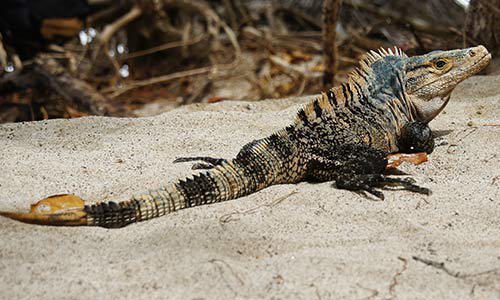Spiny-tailed Iguana
Ctenosaura hemilopha

About the Spiny-tailed Iguana

Geographic Range:

Class: Reptilia
Order: Squamata
Family: Iguanidae
Genus: Ctenosaura
Species: C. hemilopha/ C. conspicuosa Hybrids
Spiny-tailed iguanas are known for their exceptional speed, reaching up to 21.5 mph, making them the world's fastest lizards. These lizards form hierarchical colonies led by dominant males and defend their territories using their spiny tails. Their methods of communication include color changes, body movements, head bobbing and tail thrashing.
Committed to Conservation
Our conservation partner, the Northern Jaguar Project, has created a 56,000-acre Jaguar Reserve along with 125,000 acres of rangeland that is well protected through initiatives aimed at encouraging local ranchers to protect native wildlife and habitat. This reserve helps protect the Sonoran spiny-tailed iguana (Ctenosaura macrolopha), a similar and closely related species found in northwestern Mexico.
You can help!
Many lizard species are threatened by the illegal wildlife trade. Responsible pet ownership is a great way to protect wildlife. Before bringing home a new pet, ask where the animal came from and if it’s legal to own where you live. Learn more about our work to save animals from illegal trafficking.
Spiny-Tailed Iguana Facts
Appearance:
Males have prominent dorsal crests and small dewlaps (skin flaps beneath the chin), while females do not display distinct crests. The lizard derives its name from the pointed spines that run along its tail.
Size:
- Length
- Adult: Males measure up to 18 inches (snout to vent), with 18-inch tails. Females are smaller.
- Neonate: 4 – 5 inches long
- Weight
- Adult: Up to 2 pounds
- Neonate: Under 100 grams
Diet:
Primarily herbivorous, spiny-tailed iguanas eat legume fruits. Their carnivorous diet consists of small animals. Juvenile iguanas have a heavy insectivorous diet.
Reproduction:
Iguanas reach sexual maturity at 3 – 4 years of age. Their breeding season runs from May through August. After the female has signaled her receptivity, courtship begins with the male biting, scratching or licking her.
Behavior:
These lizards are predominantly terrestrial rather than arboreal, forming colonies where they collaborate to spot predators and sleep together on branches.
Iguanas exhibit a strict hierarchical system, led by a dominant male. Other males establish and defend their own territories, except for the leader. They can display aggression by using their spiny tails to strike opponents. When there’s a need for speed, they can switch from four- to two-footed locomotion when running. Reaching speeds of up to 21.5 mph, the spiny-tail iguana is recorded as the world’s fastest lizard.
Their communication involves color changes, body inflation, jaw gaping, push-ups, head bobbing, biting, and tail thrashing, often observed during territorial defense. Additionally, iguanas engage in mutual tongue licking, grooming, and body and chin rubbing.
Habitat/Range:
Spiny-tailed iguanas are found in Mexico, parts of Central America, and Islands adjacent to Panama. The subspecies C. hemilopha, in particular, is found in Baja California Sur (Mexico), and C. conspicuosa is found in San Esteban Island.
Median Life Expectancy:
15 years in the wild
Threats:
This species is threatened by habitat loss caused by agricultural activities. They also face threats from hunting for both consumption and medicinal purposes, as well as predation by free-roaming domestic cats and dogs.
You Can Find This Animal in the Treasures of the Sierra Madre
Spiny Speedsters
These iguanas are the world's fastest lizards, clocking in at speeds of up to 21.5 mph.
You might also like
At Franklin Park Zoo:
At Stone Zoo:


